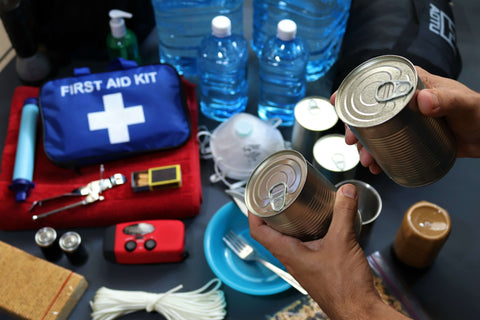
For people living in areas with a seismic hazard, it is vital to stay prepared at all times and be able to evacuate at a minute’s notice. For this reason, an emergency bag or kit is an absolute must for every household in a high-risk zone.
Keep in mind that in most cases, you will shelter in place after an earthquake. It is only if it's safest to evacuate that you would need such a kit. If you are on the coast and a tsunami is possible, for example.
Our kit lists (on-foot, ready-to-load, meals, vehicle, work, pet, wellness and toiletries) are available in the Guidebook located inside your Grab + Go Box.
So, without further ado, get the earthquake kit essentials packed and read ahead for tips on where to store yours.
Main Storage Principles for an Earthquake Kit

Determining which place is best to keep your kit may not be as easy as it seems at first thought. The criteria below will guide you through this important decision.
Accessibility
The place where you are going to store your earthquake survival kit should be easy to access in the event of an emergency.
This means that not only should it be near the spot where you spend most of the time at a specific location, but also that it is easy to take out.
Here are some critical pieces of advice to note:
- Make sure the storage space is located logically along the exit path specified in your evacuation plan.
- Don’t keep your emergency bag behind a door with a code lock, as it may be difficult to retrieve in an extreme situation.
- The best place to store an earthquake kit is the one that’s not filled with other, unrelated items - keep it organized and uncluttered.
- Avoid putting the bag in a spot where it could be buried.
Safety
Another crucial factor in deciding where to store an earthquake kit is safety.
The spot you choose should match the following characteristics:
- Be dry
- Be not accessible to uninformed strangers and children
- Be protected from domestic and wild animals
Suitable Temperature
Your earthquake preparedness kit contains essential medications alongside food and water supply. That’s why it is crucial to keep the bag in a space with suitable temperature conditions.
Some recommendations include:
- Avoid the impact of direct sunlight and other weather factors
- Check the storage temperature requirements of the first aid kit and the food supplies and follow them
- Ensure that the storage space remains cool even in hot weather conditions
Top 3 Places to Keep an Earthquake Preparedness Kit

Now that you know the main storage principles let’s move on to determining the best spaces where you can keep your earthquake kit.
Since it is hard to predict where you would be when a natural calamity hits, the wisest approach is to have multiple disaster preparedness bags stored in the locations where you spend most of your time, such as:
1. At Home
Where to keep an earthquake kit at home? The bottom of the closet full of clothes and a damp basement are not the best places to store your bag with survival essentials.
Prepare a special spot in accordance with your emergency plan and inform all the members of the household about it.
Placing your earthquake kit on a shelf next to the entryway or in a drawer near the main door is a great idea. These storage spaces will enable you to grab your bag fast when you need it the most.
2. At Your Workplace
Unless you work from home, there is a chance that you would have to evacuate from your workplace.
Determine the best spot to store your disaster preparedness bag, such as a dedicated drawer or a personal locker. Inform the staff members not to misplace the kit and leave a reminder note next to it.
3. Inside Your Vehicle
Chances are that you could be driving when a natural disaster strikes. Thus, it is wise to keep an earthquake preparedness kit in the trunk of your car in case you are not able to return home.
Besides, such a bag can come in handy even during minor inconveniences, when you need a flashlight, some food, water, or medical supplies. However, remember to always refill your emergency kit without delay.
Earthquake Kit Maintenance Tips

Getting a survival kit and storing it correctly is already a big step toward ensuring your safety in the event of an earthquake. However, it is also crucial to maintain the bag with essential gear properly for the sake of avoiding unpleasant surprises.
Here is a list of steps you can use to review your earthquake kit:
- Check the storage space for humidity, temperature, and sunlight exposure.
- Ensure that the kit is intact.
- Take your time to go over the contents of the bag to verify that nothing has expired.
- Determine whether the items packed match your current needs and add missing essentials, such as regular medications or supplies for a new pet.
- Review your earthquake evacuation plan and revise it with your family members.
Typically, conducting such a check every six months is enough for you to maintain a high earthquake readiness level.
Prepare thoroughly and stay safe!





